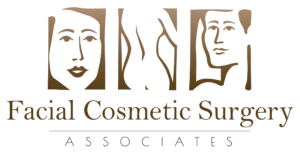Scar tissue forms during the body’s normal healing process. Scars occur when all of the layers of the skin are cut through. They can result from traumatic injury, burns, infections such as acne, and any type of surgery.
Careful planning and skillful surgical techniques can minimize the formation of noticeable scars. For instance, for individuals planning a facelift or other facial plastic surgery, the surgeon will plan the procedure so that scars will fall in natural skin creases or the hairline, where they will be scarcely noticeable.
The presence of unsightly , disfiguring scars, or defects can be disconcerting and often devastating to ones’ self image. The appearance of most scars may be improved by well planned and carefully executed surgery, but there are some important facts patients contemplating such procedures should know. Scars are usually unsightly because they may:
- be wide
- be longer then one inch
- cross natural creases of facial contour lines
- be elevated above adjacent skin
- be depressed below adjacent skin
- be a different color then the adjacent tissue
If any of these characteristics are present, improvement in any on of them should make the scar (s) less conspicuous. Correction of two or three of these factors can often result in dramatic improvement of the appearance (and sometimes function) of the scar (s).
Three common types of scars can be improved by Facial Plastic Surgery Sacramento:
- Hypertrophic or “overdeveloped” scars an excess of scar tissue that develops after an injury or surgical incision. The scar tissue appears redder in color and firmer in texture than the surrounding skin and is elevated from it.
- Keloid scars are similar to hypertrophic scars, but they continue to grow and enlarge with time, literally piling up scar tissue. The tendency to develop keloid scars may be genetic, as these scars tend to run in families.They are found more often in blacks and dark skinned people then in whit or other light skinned people. The areas most likely to develop keloid scars are the earlobes, chin and neck.
Keloids can develop after getting a cut, a blemish, having your ears pierced, having a vaccination, or just about anything that damages the skin. They are very difficult to get rid of, for anytime a keloid is cut out, it tends to grow back, sometimes larger than before. - Acne scars are the most common type of facial scarring and result from acne infections. This type of scarring is usually treated with a combination of scar revision techniques including dermabrasion.
Patients seeking scar revision should be emotionally prepared to accept several facts:
- Removal will result in another though, hopefully improved scar
- The final appearance will not be evident for 6 to 18 months, and
- More then one procedure may be required
The surgeons goal in to replace an unsightly scar with a better scar, one which is more narrow, more level, blends with the surrounding skin surface and which causes no contracture or pull on the surrounding structures; in short, one which is as inconspicuous as possible. The final appearance however is dependent on many factors, one which is the patient’s own healing capability.
Understandably, most people with recent scarring want repair immediately; however, scar revision, except in selected cases, should not be undertaken too soon. The passage of time is the best, the kindest and in the long run, the simplest treatment to give any scar of recent origin, since most will undergo spontaneous improvement if given enough time to do so. Only after the scar has become soft and white it is considered a “mature” scar. A decision regarding surgery can be made at this point. However, scars which cause distortion of normal structures (eyebrows, lips, eyelids, nostrils, etc.), those which spread widely or produce deformity by contraction and “U” or “J” shaped scars may be repaired earlier because little or no improvement can be anticipated with the passage of time.
Dr. Kaniff specializes in facial cosmetic and reconstructive surgery at 631 Fulton Avenue, Sacramento, CA (916)480-9080


